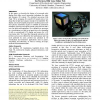1362 search results - page 179 / 273 » The future of user interface design tools |
104
Voted
SIGCSE
1992
ACM
15 years 1 months ago
1992
ACM
on through abstract instructions which approximate, but do not duplicate, the behavior of actual machines. Because they are designed for use in a variety of educational settings, C...
ACMDIS
2006
ACM
15 years 3 months ago
2006
ACM
Think-aloud testing is a widely employed usability evaluation method, yet its use in practice is rarely studied. We report an explorative study of 14 think-aloud sessions, the aud...
BCSHCI
2009
14 years 11 months ago
2009
This paper is about the evolution of a system prototype called Pensieve whose goal is to support people's reminiscing practices. A number of technologies exist to manage memo...
CHI
2010
ACM
15 years 4 months ago
2010
ACM
In this paper, we describe the design of a personal cubic display that offers novel interaction techniques for static and dynamic 3D content. We extended one-screen Fish Tank VR b...
OOPSLA
2007
Springer
15 years 4 months ago
2007
Springer
Live Sequence Charts (LSCs) is a scenario-based language for modeling object-based reactive systems with liveness properties. A tool called the Play-Engine allows users to create ...


